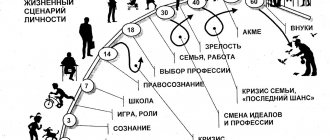Socialization factors are circumstances that encourage a person to take active action. There are only three of them - macrofactors (space, planet, country, society, state), mesofactors (ethnicity, type of settlement, media) and microfactors (family, peer groups, organizations). Let's look at each of them in more detail.
Macrofactors of socialization
Macro factors of socialization influence the socialization of all humanity or very large groups of people living in certain countries.
Macro factors include:
- Universe, or Space.
- Planet Earth.
- The entire human community.
- A country is a territory that has borders, distinguished from other territories by natural conditions and geographical location.
- Society is a set of social relations that have developed between people in a country, including in its structure the family, the state, age, social, professional and other groups.
- The state is a part of the political system of society that has power functions.
- Natural environment or geographical factor.
Are you an expert in this subject area? We invite you to become the author of the Directory Working Conditions
In the modern world, there are many problems that affect the living conditions of the individual and have an indirect or direct impact on the socialization of the individual:
- Environmental problems – environmental pollution.
- Demographic problems - growth or decline in the population of individual countries.
- Economic problems - economic crises, increasing gaps in the level of economic development of individual countries and continents.
- Military-political problems - the proliferation of nuclear weapons, the increase in the number of regional conflicts, political instability.
The socialization of an individual is influenced by the characteristics of the sex-role structure of society, predetermining ideas about the status of gender, sex-role expectations, and self-determination.
The state acts as:
- factor of socially controlled socialization: participation in the creation of educational and educational institutions (kindergartens, schools, colleges, institutes, institutions for children with poor health, etc.);
- factor regarding directed socialization: determination of the mandatory minimum education, length of service in the army, age of marriage, etc.);
- factor of spontaneous socialization: ideology, politics, social and economic practices characteristic of a given state form certain conditions for the life of its citizens.
Finished works on a similar topic
Course work Factors of personality socialization 400 ₽ Abstract Factors of personality socialization 250 ₽ Test work Factors of personality socialization 210 ₽
Receive completed work or specialist advice on your educational project Find out the cost
Microfactors of socialization
These are groups that have a direct impact on specific people: family, peer groups, organizations in which education is carried out (educational, professional, social, etc.).
Society is always concerned that the pace of socialization of the younger generation does not lag behind the pace and level of development of society itself, and carries out this process through institutions and agents of socialization (generally accepted norms, the family, as well as state and public institutions and organizations).
The leading role in the process, along with the family, belongs to educational institutions - kindergartens, schools, secondary and higher educational institutions. An indispensable condition is also his communication with peers, which develops in kindergarten groups, school classes, and various children's and adolescent associations. Teachers are agents of socialization, responsible for teaching cultural norms and internalizing roles.
Mesofactors of socialization
Mesofactors of socialization are certain conditions for the socialization of groups of people united:
- national sign;
- type and location of settlement (town, village, city, region);
- belonging to the audience of one or another mass communication medium (computers, television, radio, cinema, etc.).
Ethnic characteristics that influence the method of socialization are divided into:
- vital, or vital (health, nutrition, methods of physical development);
- mental or spiritual.
Features of socialization, determined by the type and place of socialization:
- Significant social control over individual behavior, openness in communication in towns and villages.
- A wide choice of value systems, communication groups, lifestyle, significant opportunities for self-realization in the city.
- Main functions of mass media:
- Socio-psychological function: the need for connections with other people, satisfaction in receiving information that supports his ideas, values, views.
- Dissemination of knowledge in the field of science and culture.
- Social management and regulation, maintaining public relations.
Social pedagogy
4. Socialization factors
When socializing children and adolescents, conditions operate that are commonly called factors. Of the known factors, not all have been studied, and knowledge about those that have been studied is very scarce and uneven. More or less studied conditions or factors of socialization are combined into 4 groups.
The first is megafactors
(from the English “mega” - “very large, universal”) - space, planet, world, which to one degree or another through other groups of factors influence the socialization of all inhabitants of the Earth.
Second - macro factors
(from the English “macro” - “big”), influencing the socialization of the country, ethnic group, society, state.
Third - mesofactors
(from the English “meso” - “average, intermediate”), which allow you to distinguish groups of people by: area and type of village in which they live (region, village, city); belonging to listeners of certain mass communication networks (radio, television, etc.); belonging to certain subcultures.
Socialization is influenced by mesofactors both directly and indirectly through the fourth group - microfactors.
These include factors that directly influence specific people - family and home, neighborhood, peer groups, educational organizations, various public, state, religious, private and counter-social organizations, microsociety.
The most important role in how a person grows up, how his formation goes, is played by the people in direct interaction with whom his life flows. They are called agents of socialization.
While an individual is in adolescence, agents are parents, brothers and sisters, relatives, peers, neighbors, and teachers.
In their role in socialization, agents differ depending on how significant they are for a person, how interaction with them is structured, in what direction and by what means they exert their influence. The socialization of a person is carried out by a wide range of universal means, the content of which is specific to a particular society, a particular social stratum, a particular age of the person being socialized. These include:
1) methods of feeding and caring for an infant;
2) developed household and hygienic skills;
3) the fruits of material culture surrounding a person;
4) elements of spiritual culture (from lullabies and fairy tales to sculptures); style and content of conversations;
5) methods of reward and punishment in the family, in peer groups, in educational and other socializing organizations;
6) consistent introduction of a person to numerous types and types of relationships in the main spheres of his life - communication, play, cognition, subject-practical and spiritual-practical activities, sports, as well as in the family, professional, social, religious spheres.
Socialization in cyberspace
Bondarenko defines socialization in cyberspace as “...the process of the user’s entry (integration) into the sociocultural environment through the development of communication technologies, information culture, social navigation, information literacy, as well as social norms, values and role requirements. Indicators of socialization are the levels of electronic literacy and information culture of an individual...”
- Bondarenko S.V. Social structure of virtual network communities. Rostov: Rostov State. University, 2004. 319 p. (p. 90).
- Efimova T.V. Socialization in the conditions of post-industrial culture // Man and Education. 2011. No. 4. pp. 4–9.
Internet as an institution of socialization
Computer networks play a special role in the spontaneous socialization of younger generations. Working with a computer, on the one hand, leads to the expansion of contacts, opportunities for the exchange of sociocultural values, the generation and implementation of new forms of symbolic experience, the development of imagination processes, the intensification of the study of foreign languages and a number of other positive effects. The development of electronic systems has given rise to a completely new type of communication and self-realization - the interaction of a person with certain partners of interest to him for one reason or another, which allows him to find like-minded people and express himself in communication with them.
It is absolutely obvious that everyday practices, unique from the point of view of classical institutional models, are being formed in the network space, unified and having a fairly clear structure. There is a formalized, sustainable organization of joint activities of people aimed at meeting social needs. In fact, we are talking about a social institution - no less important a social institution than politics, art, education or science, but one that has great popularity in society due to its coverage, transformation of transmission and reproduction of virtually all stable forms of social relations. Social practice shows that it is vital for human society to consolidate certain types of social relations, to make them mandatory for members of a certain society or a certain social group. This primarily refers to those social relationships, by entering into which members of a social group ensure the satisfaction of the most important needs necessary for the successful functioning of the group as an integral social unit. The Internet provides phenomenal opportunities for the realization of many needs, social and cultural in the first place.
Models of socialization
- Sikorskaya L.E. The crisis of institutions of socialization of modern youth // BULLETIN OF KOstroma STATE UNIVERSITY. ON THE. NEKRASOVA. SERIES: PEDAGOGY. PSYCHOLOGY. SOCIAL WORK. JUVENOLOGY. SOCIOKINETICS. 2009. No. 4. P. 258 – 265.
- VOLUNTEER ACTIVITY AND MODELS OF SOCIALIZATION OF YOUTH
Forced socialization
Forced socialization is a model of social formation of personality, which is based on means of coercion, suppression, oppression, and violence against an individual in order to subjugate and control him from society. The forced model of socialization, starting from the indicated opposition, does not shun all kinds of attempts to belittle and discredit the value of human individuality, since it poses a danger, a threat to the depersonalized structure of society. The coercive model is based on the motivation of fear, which it feeds and supports in every possible way, resorting to all kinds of intimidation and repression. It is fear that becomes the motivational spring that forces individuals to obey and act in favor of other people's demands, even if they run counter to their own desires. Fear of avoiding punishment is often hidden behind many forms of social activity that appear to be voluntary. Within the framework of the compulsory model, the individual is assigned external responsibility in the form of an endless, usually inexhaustible debt to society (group), to which he owes everything he has (and even the fact that he lives and breathes). The appeal to an individual from the side of society is imperative in nature, in orderly, administrative and conscription vocabulary. Monologue dominates in society; the flow of information is dosed and unidirectional in nature without feedback and lively social reflection. the model of forced socialization, in essence, is a project created by individuals who are not self-sufficient, dependent, internally weak for the production of their own kind. If this model dominates in a society, if it produces an endless, vicious circle of coercion and violence, then such a society inevitably gives rise to victims of socialization.
Adaptive socialization
Society strives to treat a person with greater attention, strives to study him, his demands, needs, etc. At the same time, society is already more selective in the means and methods of influence so that they do not provoke resistance and rejection on the part of the individual, but to a certain extent meet his immediate needs. At the same time, within the framework of the adaptive model, as in compulsory practice, the developing individual is considered as an object of socialization, requiring gradual inclusion in the sociocultural process through training and education within the framework of standards established by social norms and institutions. In this model, the pair “person - society” as the main participants in socialization, as well as in the previous model, are considered initially disconnected, distant from each other, although not necessarily opposed to each other.
Society as a subject of socialization is considered as the main carrier of social experience and norms, and the individual as an object is a person who assimilates this experience, is guided by it and reproduces it in his actions. At the same time, it is important to emphasize that a person in this model does not become a full-fledged subject of socialization. The model of adaptive socialization includes the functioning of all types of social communities and groups that profess the principles of a social contract, democracy, adhering to various kinds of conventions, agreements, compromises, rights of private life, property, etc., as well as the basic freedoms of a civilized society.
In the adaptive model of socialization, instead of direct coercion and pressure, there is a complex and branched system of means of social reinforcement (positive and negative), well known from psychological developments in line with neo-behaviorism by B.F. Skinner as programmed behavior. The individual seems to move in the labyrinth of life, relying on the prompts of society. It gives him guiding signs, signals and rewards, and thereby leads him in the direction he needs. And what is often perceived as an independent achievement may in fact be nothing more than the ability to skillfully “read signs”, i.e. adapt to the existing rules of the game. Technologically, the task of this model is to produce as many scenarios as possible for programming individuals for “all occasions” in order to control and manage people’s behavior. Thus, the adaptive model also creates victims of socialization. The motivational basis on which this model is built seems to be the needs of social acceptance, the desire to be like everyone else, fear of isolation and loneliness, fear of losing social benefits, etc. But the main motivational source here is obviously the individual’s desire to avoid the difficult burden of internal responsibility for his destiny and life in this world.
The theory of social exchange, according to which people exchange not only material goods, but also social goods - love, services, information, status. This means that by showing kindness to others, a person makes subtle calculations about reward that precede the action. The reward may include career considerations, increased social adaptability, decreased feelings of guilt, strengthened self-esteem, etc.
Incentive socialization
Incentive socialization is aimed at awakening his personality in a person, appealing to his self-awareness, dignity, conscience, and moral sense. This model is based on the fundamental position of the unity of society and the developing individual, who is not opposed to society and is not removed from it, but from the very beginning is built into the fabric of social connections and relationships, refracting them in its essence. At the same time, the person himself does not dissolve in society, but retains his autonomy and acts as the bearer of his unique way of life. Human nature in this model is conceived not as predetermined by the presence of evil and good principles, but as a set of abilities, potentials and development opportunities. The incentive model is implemented on the basis of the value of free will as positive freedom (“freedom for”), and its embodiment is the spontaneous activity of the individual. This model is based on the recognition of the possibility of positive freedom, in which, as E. Fromm notes, the individual exists as an independent person, but not isolated, but connected with the world, with other people and with nature. At the same time, the process of developing freedom is not a vicious circle; a person can be free but not alone, critical but not overwhelmed by doubt, independent but inextricably linked to humanity.
The resource of the incentive model of socialization is not the power of power, temptation or manipulation, but the power of authority and moral example, calling a person to the full realization of his personality through devoting himself to the values of good and good. Hence, this model posits a purely personalized channel of interaction and communication, when society, represented by the authorities, does not hide from the individual in anonymous media channels, formal procedures and bureaucratic niches, but directly addresses him as an individual and a citizen. At the same time, the information is not distorted or dosed, but is presented in a complete and open form, objectively reflecting the essence of the processes occurring in society. That is, within the framework of the incentive model, socializing influence is exerted according to the principle of “reflected subjectivity.”
Society, represented by individuals, on the one hand, addresses the developing individual as an individual, on the other hand, appealing to his self-awareness, establishing direct cooperation and full-fledged dialogue within the framework of common affairs on the basis of mutual participation and trust. Elements of trust are people’s shared views on a person’s place in society, their interests and intentions, commitment to family values, ethical, religious and ethnic traditions, national identity and much more. Trust is what makes a community a society, just as, for example, laws make a management system a state, since laws themselves only fill the vacuum formed in the absence of trust. The motivational basis of the incentive model is the natural desire of a person for self-realization and self-actualization, as well as love as the highest moral feeling.
Types of socialization
Sciences that study society distinguish the following types of socialization:
- full and partial;
- directional and non-directional;
- family and household;
- professional and labor (organizational);
- subcultural;
- group;
- resocialization;
- gender (sex-role).
A person is formed under the influence of limiting, stimulating, directing and shaping institutions and agents.
Scientists developing sociological theory classify as agents people who are responsible for developing social values in a subject and teaching him cultural norms - teachers, friends, leaders of youth groups, relatives.
No less important influences on people come from the media, churches, law enforcement agencies, the armed forces, businesses, educational institutions and representatives of the administration of educational institutions - public institutions.
Primary socialization
In accordance with the age of the individual, primary socialization can be distinguished - in the first half of life, and secondary, covering maturity and old age.
Inclusion in social structures begins in the circle of family and friends. From a normative and substantive point of view, agents taking part in adaptation processes during this period are classified as informal. Contacts are carried out at the interpersonal level; their form and content are not fundamentally regulated.
In the future, representatives of formal structures - public and state institutions - play a large socializing role. They act on the basis of documents defining the time, order and content of relationships.
Informal institutions function throughout life, but are most influential during the period of personality formation - in childhood and adolescence, as well as in old age. In midlife, formal business relationships come to the fore.
The first patterns of behavior and social sanctions are laid down in the family. Here norms of mutual assistance and moral responsibility are developed. Family education involves:
- participation of an adult in the process;
- an individualized form of transmission of human experience;
- meeting the child's basic needs;
- determining children's attitudes towards learning;
- formation of a person’s level of aspirations through condemnation, indifference, support or approval of his decisions and behavior.
Initial adaptation is often spontaneous and depends on the relationships of family members, lifestyle, their prosocial or antisocial attitudes, material conditions, social status, level of education and composition.
Resocialization
Examples of socialization studied by science contain a process that sometimes occurs in adults in the second half of life - resocialization. It can be caused by the subject consciously or have an unconscious nature. Under the influence of new circumstances, the individual is forced to adapt to the changing requirements of the environment.
The secondary adaptation process is started:
- change in social status and role of a person in society;
- stress factors: death of loved ones, illness, natural disaster, global social conflicts;
- conditions that cause isolation of the subject, for example, ending up in a military school, a psychiatric hospital, a colony, or any other closed institution, with its own norms and values.
Secondary processes occur in different forms:
- Superficial. Only fundamental values and external patterns of behavior are not corrected.
- Adaptive. Norms and rules change to help adapt to the situation.
- Identification. The individual is required to reconsider the basic beliefs and assessments that underlie his self-identification.
Group
The levels of socialization of an individual also depend on the characteristics and composition of the groups to which he belongs in one way or another. A community of people can be considered a group if:
- its members interact regularly;
- there are interaction goals that are common;
- participants act as a single organism and carry out group behavior;
- the group is characterized by self-identification;
- people from the outside define the community as a single whole.
The basis of consolidation is ideology. Members of a team have the same beliefs, values, motives, goals and implement group behavioral patterns.
A person identifies himself as a member of a community and realizes its difference from other social formations. The following parts can be distinguished in the socializing mechanism of a group:
- obligations assumed by a member of the association if he is satisfied with the quality and volume of rewards (benefits) received from interaction;
- assessment by the group and the individual of the consequences of the implementation of mutual expectations, declared norms and goals;
- role changes that occur as a result of the dynamics of the “individual-group” relationship, when there is a correction of the obligations assumed by the parties.
The stages that a subject goes through during role movements:
- No membership. The status is typical for those who have left the team or its potential participants.
- Quasi-membership. People who do not live up to the expectations of the group or who do not achieve full membership are given this status.
- Full members of the group. They enjoy all available privileges and take on the full range of social obligations.
Gender
Spontaneous socialization leads to the fact that a child begins to identify himself as female or male around 3 years from birth, and at the age of 3-7 he already understands that it is impossible to change gender.
Factors that influence gender-role self-identification and adaptation:
- Society punishes unacceptable gender-role behavior and rewards when actions correspond to the gender vector, thereby increasing differentiation.
- The division by gender is influenced by imitation, which is characteristic of children following the example of behavior patterns that exist in the family, at school, and among peers.
It is typical for society that it condemns the feminine behavior of boys, but tolerates it when girls behave masculinely.
Socializing mechanisms based on gender from the point of view of psychology are:
- gender-role behavior patterns;
- understanding gender roles;
- social expectations;
- social reinforcements;
- identification.
Organizational
Means of socialization are used in training employees in different organizational structures.
A positive result of a person’s adaptation process in a company can be stated if:
- the new employee has no uncertainty, fear, or feeling of tension;
- the employee has become accustomed to his professional role, acquired the necessary skills and the required amount of knowledge;
- managers are satisfied with the results of his work;
- the assessment of the labor contribution by management and the team satisfies the employee;
- a new member of the work team wants to develop in the profession and connects his success in life with this.
In order for a person to become a full-fledged part of the structure of an enterprise, he must learn patterns of professional behavior, sociocultural and moral values of the organization.
A company's ability to socialize new members can be assessed by analyzing employee turnover, productivity, and employee commitment to the firm.
Problems that have to be solved in the process of a subject’s entry into the production structure:
- change in human behavior;
- correction of organizational requirements and conditions;
- optimization of interaction between the organizational environment and the new employee.
In addition to the official requirements, during the adaptation process new employees will learn:
- distribution of power;
- unwritten, but mandatory norms and rules;
- approved appearance;
- behavioral stereotypes inherent to the position;
- permissible freedoms in carrying out work schedules and using time for rest.
Early
The problem of socialization arises at the stage of an individual making decisions about certain forms of cooperation with society.
Before the subject assumes full legal obligations and the resulting responsibility, there are ways to first familiarize him with the requirements and norms of social structures, the conditions of interaction with the future social environment.
A person is given the opportunity ahead of schedule to be in the role of a member of a group, to get acquainted with its traditions, patterns of behavior, cultural, ethical and aesthetic preferences.
Social institutions offering early socialization:
- Communities of interests and professions. A person can attend meetings, seminars, and participate in open events organized by such structures specifically for the purpose of familiarizing future members with the terms of cooperation.
- Educational establishments. Before entering a university, you can attend lectures, participate in practical classes, and take preliminary courses at a university, institute, or college.
- Family. Some couples prefer to live together before marriage in order to get to know family relationships better and experience the nuances and problems of living together.
- Religion. A conscious choice of religion presupposes preliminary familiarization with the teaching, the features of its traditions and rituals, literature, and the nature of the lives of followers.
- Armed forces. At some military institutes and schools, permanent courses are organized, where a future officer can live the life of a serviceman, participate in the education process and training, before finally throwing in his lot with the army.
- Penitentiary system. For troubled teenagers who have come to the attention of the police, events are held that give them the opportunity to familiarize themselves with the conditions of detention of prisoners in prisons and colonies, and to experience the social status of a person whose rights have been infringed.








